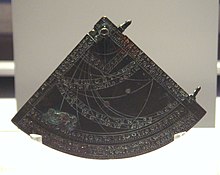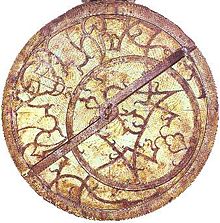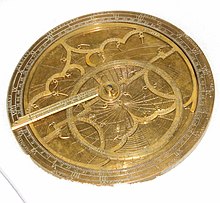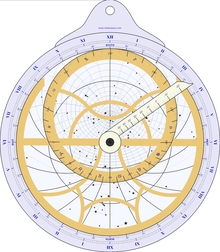Astrolabe: Difference between revisions
ClueBot NG (talk | contribs) m Reverting possible vandalism by 71.174.74.41 to version by Michael Hardy. False positive? Report it. Thanks, ClueBot NG. (1059073) (Bot) |
|||
| Line 9: | Line 9: | ||
[[OED]] gives the translation "star-taker" for the English word "astrolabe" and traces it, through medieval Latin, to a Greek word ''astrolabon''.<ref name=oed/> In the medieval Islamic world the word "asturlab" (i.e. astrolabe) was given various etymologies. In Arabic texts the word is translated as "akhdh al-kawakib" (lit. "taking the stars") which corresponds to an interpretation of the Greek word <ref>{{Harvcoltxt|King|1981|p=44}}</ref>. [[al-Biruni]] quotes and criticizes the medieval scientist [[Hamza al-Isfahani]] who had stated <ref>{{Harvcoltxt|King|1981|p=44}}</ref> " asturlab is an arabization of this Persian phrase" : ''sitara yab'' meaning "taker of the stars" <ref>{{Harvcoltxt|King|1981|p=51}}</ref> In medieval Islamic sources there is also a "fictional" and popular etymology of the words as "lines of lab". In this [[folk etymology|popular etymology]] "Lab" is a certain son of Idris (=Enoch). This etymology is mentioned by a 10th-century scientist called [[al-Qummi]] but rejected by [[al-Khwarizmi]] <ref>{{Harvcoltxt|King|1981|p=45}}</ref>. |
[[OED]] gives the translation "star-taker" for the English word "astrolabe" and traces it, through medieval Latin, to a Greek word ''astrolabon''.<ref name=oed/> In the medieval Islamic world the word "asturlab" (i.e. astrolabe) was given various etymologies. In Arabic texts the word is translated as "akhdh al-kawakib" (lit. "taking the stars") which corresponds to an interpretation of the Greek word <ref>{{Harvcoltxt|King|1981|p=44}}</ref>. [[al-Biruni]] quotes and criticizes the medieval scientist [[Hamza al-Isfahani]] who had stated <ref>{{Harvcoltxt|King|1981|p=44}}</ref> " asturlab is an arabization of this Persian phrase" : ''sitara yab'' meaning "taker of the stars" <ref>{{Harvcoltxt|King|1981|p=51}}</ref> In medieval Islamic sources there is also a "fictional" and popular etymology of the words as "lines of lab". In this [[folk etymology|popular etymology]] "Lab" is a certain son of Idris (=Enoch). This etymology is mentioned by a 10th-century scientist called [[al-Qummi]] but rejected by [[al-Khwarizmi]] <ref>{{Harvcoltxt|King|1981|p=45}}</ref>. |
||
the astocrap is not a ggod tool. he id fat i do not likey him at all. a math id g9ood. i rule |
|||
==History== |
|||
===Ancient world=== |
|||
An early astrolabe was invented in the [[Hellenistic civilization|Hellenistic world]] in 150 BC and is often attributed to [[Hipparchus]]. A marriage of the [[planisphere]] and [[dioptra]], the astrolabe was effectively an analog calculator capable of working out several different kinds of problems in spherical astronomy. [[Theon of Alexandria]] wrote a detailed treatise on the astrolabe, and {{Harvcoltxt|Lewis|2001}} argues that [[Ptolemy]] used an astrolabe to make the astronomical observations recorded in the ''[[Tetrabiblos]]''.<ref>{{Harvcoltxt|Evans|1998|pp=155}} "The astrolabe was in fact an invention of the ancient Greeks."<br>{{Harvcoltxt|Krebs|Krebs|2003|p=56}} "It is generally accepted that Greek astrologers, in either the first or second centuries BC, invented the ''astrolabe'', an instrument that measures the altitude of stars and planets above the horizon. Some historians attribute its invention to Hipparchus"</ref> |
|||
Astrolabes continued in use in the [[Greek language|Greek]]-speaking world throughout the [[Byzantine Empire|Byzantine]] period. About 550 AD the Christian philosopher [[John Philoponus]] wrote a treatise on the astrolabe in Greek, which is the earliest extant Greek treatise on the instrument.<ref>Modern editions of John Philoponus' treatise on the astrolabe are ''On the Use and Construction of the Astrolabe,'' ed. H. Hase, Bonn: E. Weber, 1839 (or id. Rheinisches Museum für Philologie 6 (1839): 127–71); repr. and translated into French by A.P. Segonds, ''Jean Philopon, traité de l'astrolabe,'' Paris: Librairie Alain Brieux, 1981; and translated into English by H.W. Green in R.T. Gunther, ''The Astrolabes of the World,'' Vol. 1/2, Oxford, 1932, repr. London: Holland Press, 1976, pp. 61–81.</ref> In addition, [[Severus Sebokht]], a bishop who lived in Mesopotamia, also wrote a treatise on the astrolabe in Syriac in the mid-7th century.<ref>{{Citation| publisher = Routledge and Kegan Paul| last = O'Leary| first = De Lacy| title = How Greek Science passed to the Arabs| year = 1948| url = http://www.aina.org/books/hgsptta.htm}} "The most distinguished Syriac scholar of this later period was [[Severus Sebokht]] (d. 666-7), Bishop of Kennesrin. [...] In addition to these works [...] he also wrote on astronomical subjects (Brit. Mus. Add. 14538), and composed a treatise on the astronomical instrument known as the astrolabe, which has been edited and published by F. Nau (Paris, 1899)." <br/>Severus' treatise was translated by Jessie Payne Smith Margoliouth in R.T. Gunther, ''Astrolabes of the world'' Oxford, 1932, pp. 82–103.</ref> [[Severus Sebokht]] refers in the introduction of his treatise to the astrolabe as being made of brass, indicating that metal astrolabes were known in the Christian East well before they were developed in the Islamic world or the Latin West.<ref>Severus Sebokht, ''Description of the astrolabe'' http://www.tertullian.org/fathers/severus_sebokht_astrolabe_01_trans.htm</ref> |
|||
===Medieval era=== |
|||
[[File:Tusi manus.jpg|250px|right|thumb|A Treatise explaining the importance of the Astrolabe by [[Nasir al-Din al-Tusi]], Iranian scientist.]] |
|||
[[File:Jean Fusoris planispheric astrolabe in Putnam Gallery, 2009-11-24.jpg|thumb|200px|Astrolabe of Jean Fusoris, made in [[Paris]], 1400]] |
|||
[[File:Astrolabe-Persian-18C.jpg|right|thumb|An 18th-century Persian astrolabe]] |
|||
[[File:Astrolabe, 18th century, disassembled.jpg|thumb|Disassembled 18th-century astrolabe]] |
|||
Astrolabes were further developed in the [[Islamic Golden Age|medieval Islamic world]], where [[Astronomy in medieval Islam|Muslim astronomers]] introduced angular scales to the astrolabe,<ref>See p. 289 of {{Citation |
|||
| doi = 10.1088/1475-4878/24/5/302| issn = 1475-4878| volume = 24| issue = 5| pages = 289–303| last = Martin| first = L. C.| title = Surveying and navigational instruments from the historical standpoint| journal = Transactions of the Optical Society| year = 1923| url = http://iopscience.iop.org/1475-4878/24/5/302/ |
|||
| postscript = .}}</ref> adding circles indicating [[azimuth]]s on the [[horizon]].<ref>{{citation|title=The mathematics of Egypt, Mesopotamia, China, India, and Islam: a sourcebook|author=Victor J. Katz & Annette Imhausen|publisher=[[Princeton University Press]]|year=2007|isbn=0691114854|page=519}}</ref> It was widely used throughout the Muslim world, chiefly as an [[Geography in medieval Islam|aid to navigation]] and as a way of finding the [[Qibla]], the direction of [[Mecca]]. The first person credited with building the astrolabe in the Islamic world is reportedly the 8th century [[Mathematics in medieval Islam|mathematician]] [[Muhammad al-Fazari]].<ref>[[Richard Nelson Frye]]: Golden Age of Persia. p. 163</ref> The mathematical background was established by the Muslim astronomer [[Muhammad ibn Jābir al-Harrānī al-Battānī|Albatenius]] in his treatise ''Kitab az-Zij'' (ca. 920 AD), which was translated into Latin by [[Plato Tiburtinus]] (''De Motu Stellarum''). The [http://www.soas.ac.uk/gallery/islamicpatronage/popup25732.html earliest surviving dated astrolabe] is dated [[Islamic calendar|AH]] 315 (927/8 AD). In the Islamic world, astrolabes were used to find the times of sunrise and the rising of fixed stars, to help schedule morning prayers ([[salat]]). In the 10th century, [[al-Sufi]] first described over 1,000 different uses of an astrolabe, in areas as diverse as [[astronomy]], [[Islamic astrology|astrology, horoscope]]s, [[Mariner's astrolabe|navigation]], [[surveying]], [[time]]keeping, [[prayer]], [[Salah]], [[Qibla]], etc.<ref>Dr. Emily Winterburn ([[National Maritime Museum]]), [http://www.muslimheritage.com/topics/default.cfm?ArticleID=529 Using an Astrolabe], Foundation for Science Technology and Civilisation, 2005.</ref>{{verify credibility|date=January 2012}} |
|||
The [[spherical astrolabe]], a variation of both the astrolabe and the [[armillary sphere]], was invented during the [[Middle Ages]] by astronomers and [[Inventions in the Muslim world|inventors]] in the Islamic world.<ref>Emilie Savage-Smith (1993). "Book Reviews", ''Journal of Islamic Studies'' '''4''' (2), pp. 296–299. {{quote|"There is no evidence for the Hellenistic origin of the spherical astrolabe, but rather evidence so far available suggests that it may have been an early but distinctly Islamic development with no Greek antecedents."}}</ref> The earliest description of the spherical astrolabe dates back to [[Al-Nayrizi]] ([[floruit|fl.]] 892–902). In the 12th century, [[Sharaf al-Dīn al-Tūsī]] invented the ''linear astrolabe'', sometimes called the "staff of al-Tusi," which was "a simple wooden rod with graduated markings but without sights. It was furnished with a plumb line and a double chord for making angular measurements and bore a perforated pointer."<ref name=MacTutor>{{MacTutor|id=Al-Tusi_Sharaf|title=Sharaf al-Din al-Muzaffar al-Tusi}}</ref> The first [[gear]]ed mechanical astrolabe was later invented by Abi Bakr of [[Isfahan]] in 1235.<ref name=Bedini>Silvio A. Bedini, Francis R. Maddison (1966). "Mechanical Universe: The Astrarium of Giovanni de' Dondi", ''Transactions of the American Philosophical Society'' '''56''' (5), pp. 1–69.</ref> |
|||
[[Peter of Maricourt]], in the last half of the 13th century, also wrote a treatise on the construction and use of a universal astrolabe (''Nova compositio astrolabii particularis''). Universal astrolabes can be found at the History of Science Museum in Oxford. |
|||
The English author [[Geoffrey Chaucer]] (ca. 1343–1400) compiled a [[Treatise on the Astrolabe|treatise on the astrolabe]] for his son, mainly based on [[Mashallah ibn Athari|Messahalla]]. The same source was translated by the French astronomer and astrologer [[Pelerin de Prusse]] and others. The first printed book on the astrolabe was ''Composition and Use of Astrolabe'' by [[Cristannus de Prachaticz]], also using Messahalla, but relatively original. |
|||
In 1370, the first [[India]]n treatise on the astrolabe was written by the [[Jainism|Jain]] astronomer [[Mahendra Suri]].<ref>{{Citation | last = Glick, eds. | title = Medieval Science, Technology, and Medicine: An Encyclopedia | year = 2005 | publisher = Routledge | isbn = 0415969301 | pages = 464 | display-authors = 1 | author2 = <Please add first missing authors to populate metadata.> }}</ref> |
|||
The first known metal astrolabe known in Western Europe was developed in the 15th century by [[Rabbi]] [[Abraham Zacuto]] in [[Lisbon]]. Metal astrolabes improved on the accuracy of their wooden precursors.{{Citation needed|date=June 2010}} In the 15th century, the French instrument-maker [[Jean Fusoris]] (ca. 1365–1436) also started selling astrolabes in his shop in [[Paris]], along with portable [[sundial]]s and other popular scientific [[gadget]]s of the day. Finally, one more special example of craftsmanship in the early 15th-century Europe is the astrolabe dated 1420, designed by Antonius de Pacento and made by Dominicus de Lanzano.<ref>Ralf Kern: Wissenschaftliche Instrumente in ihrer Zeit. Band 1: Vom Astrolab zum mathematischen Besteck. Cologne, 2010. S. 204. ISBN 978-3-86560-865-9</ref> |
|||
In the 16th century, [[Johannes Stöffler]] published ''Elucidatio fabricae ususque astrolabii'', a manual of the construction and use of the astrolabe. Four identical 16th-century astrolabes made by [[Georg Hartmann]] provide some of the earliest evidence for [[batch production]] by [[division of labor]]. |
|||
===Astrolabes and clocks=== |
|||
[[File:Persian astrolabe.jpg|thumb|A modern Persian astrolabe, made in [[Tabriz]] in 1991.]] |
|||
At first mechanical [[astronomical clock]]s were influenced by the astrolabe; in many ways they could be seen as clockwork astrolabes designed to produce a continual display of the current position of the sun, stars, and planets. For example, [[Richard of Wallingford]]'s clock (c. 1330) consisted essentially of a star map rotating behind a fixed rete, similar to that of an astrolabe.<ref>John David North, "God's Clockmaker: Richard of Wallingford and the Invention of Time", Continuum International Publishing Group, 2005, ISBN 978-1-85285-451-5</ref> |
|||
Many astronomical clocks, such as the famous [[Prague Orloj|clock at Prague]], use an astrolabe-style display, adopting a stereographic projection (see below) of the ecliptic plane. |
|||
In 1985 Swiss watchmaker Dr. Ludwig Oechslin designed and built an [http://www.ulysse-nardin.ch/en/swiss_watch_manufacturer/Collection/Archive/Astrolabium_G._Galilei.html astrolabe wristwatch] in conjunction with [[Ulysse Nardin]]. |
|||
==Construction== |
==Construction== |
||
Revision as of 17:27, 7 May 2012


An astrolabe ([ἀστρολάβον astrolabon, "star-taker"] Error: {{Lang-xx}}: text has italic markup (help))[1] is an elaborate inclinometer, historically used by astronomers, navigators, and astrologers. Its many uses include locating and predicting the positions of the Sun, Moon, planets, and stars, determining local time given local latitude and vice-versa, surveying, triangulation, and to cast horoscopes. It was used in classical antiquity, through the Islamic Golden Age, the European Middle Ages and Renaissance for all these purposes. In the Islamic world, it was also used to calculate the Qibla and to find the times for Salah, prayers.
There is often confusion between the astrolabe and the mariner's astrolabe. While the astrolabe could be useful for determining latitude on land, it was an awkward instrument for use on the heaving deck of a ship or in wind. The mariner's astrolabe was developed to address these issues.
Etymology
OED gives the translation "star-taker" for the English word "astrolabe" and traces it, through medieval Latin, to a Greek word astrolabon.[1] In the medieval Islamic world the word "asturlab" (i.e. astrolabe) was given various etymologies. In Arabic texts the word is translated as "akhdh al-kawakib" (lit. "taking the stars") which corresponds to an interpretation of the Greek word [2]. al-Biruni quotes and criticizes the medieval scientist Hamza al-Isfahani who had stated [3] " asturlab is an arabization of this Persian phrase" : sitara yab meaning "taker of the stars" [4] In medieval Islamic sources there is also a "fictional" and popular etymology of the words as "lines of lab". In this popular etymology "Lab" is a certain son of Idris (=Enoch). This etymology is mentioned by a 10th-century scientist called al-Qummi but rejected by al-Khwarizmi [5].
the astocrap is not a ggod tool. he id fat i do not likey him at all. a math id g9ood. i rule
Construction


An astrolabe consists of a disk, called the mater (mother), which is deep enough to hold one or more flat plates called tympans, or climates. A tympan is made for a specific latitude and is engraved with a stereographic projection of circles denoting azimuth and altitude and representing the portion of the celestial sphere above the local horizon. The rim of the mater is typically graduated into hours of time, degrees of arc, or both. Above the mater and tympan, the rete, a framework bearing a projection of the ecliptic plane and several pointers indicating the positions of the brightest stars, is free to rotate. Some astrolabes have a narrow rule or label which rotates over the rete, and may be marked with a scale of declinations.
The rete, representing the sky, functions as a star chart. When it is rotated, the stars and the ecliptic move over the projection of the coordinates on the tympan. One complete rotation corresponds to the passage of a day. The astrolabe is therefore a predecessor of the modern planisphere.
On the back of the mater there is often engraved a number of scales that are useful in the astrolabe's various applications; these vary from designer to designer, but might include curves for time conversions, a calendar for converting the day of the month to the sun's position on the ecliptic, trigonometric scales, and a graduation of 360 degrees around the back edge. The alidade is attached to the back face. An alidade can be seen in the lower right illustration of the Persian astrolabe above. When the astrolabe is held vertically, the alidade can be rotated and the sun or a star sighted along its length, so that its altitude in degrees can be read ("taken") from the graduated edge of the astrolabe; hence the word's Greek roots: "astron" (ἄστρον) = star + "lab-" (λαβ-) = to take.
See also
- Antikythera mechanism
- Armillary sphere
- Astrarium
- Astronomical clock
- Cosmolabe
- Equatorium
- Islamic astronomy
- Orrery
- Philippe Danfrie, designer and maker of mathematical instruments, globes and astrolabes
- Planetarium
- Planisphere
- Prague Orloj
- Sextant (astronomical)
- Sharafeddin Tusi, the inventor of the linear astrolabe
- Torquetum
- Canterbury Astrolabe Quadrant
- Hypatia
- Marshall Islands stick chart
Notes
- ^ a b astrolabe, Oxford English Dictionary 2nd ed. 1989
- ^ King (1981:44)
- ^ King (1981:44)
- ^ King (1981:51)
- ^ King (1981:45)
References
- Evans, James (1998), The History and Practice of Ancient Astronomy, Oxford University Press, ISBN 0195095391.
- Alessandro Gunella and John Lamprey, Stoeffler's Elucidatio (translation of Elucidatio fabricae ususque astrolabii into English). Published by John Lamprey, 2007.
- Krebs, Robert E.; Krebs, Carolyn A. (2003), Groundbreaking Scientific Experiments, Inventions, and Discoveries of the Ancient World, Greenwood Press.
- Edgar Laird. "Astrolabes and the Construction of Time in the Late Middle Ages." In: Constructions of Time in the Late Middle Ages. Ed. Carol Poster and Richard Utz. Evanston, IL: Northwestern University Press, 1997, pp. 51–69.
- King, D. A (1981), "The Origin of the Astrolabe According to the Medieval Islamic Sources", Journal for the History of Arabic Science, 5: 43–83
- Lewis, M. J. T. (2001), Surveying Instruments of Greece and Rome, Cambridge University Press.
- Morrison, James E (2007), The Astrolabe, Janus, ISBN 9780939320301.
- John North. God's Clockmaker, Richard of Wallingford and the invention of time. Hambledon and London, 2006.
- Critical edition of Pelerin de Prusse on the Astrolabe (translation of Practique de Astralabe). Editors Edgar Laird, Robert Fischer. Binghamton, New York, 1995, in Medieval & Renaissance Texts & Studies. ISBN 0-86698-132-2
- King, Henry Geared to the Stars: the evolution of planetariums, orreries, and astronomical clocks University of Toronto Press, 1978
External links
- paper astrolabe generator, from the ESA
- "Hello World!" for the Astrolabe: The First Computer Video of Howard Covitz's Presentation at Ignite Phoenix, June 2009. Slides for Presentation Licensed as Creative Commons by-nc-nd.
- Video of Tom Wujec demonstrating an astrolabe. Taken at TEDGlobal 2009. Includes clickable transcript. Licensed as Creative Commons by-nc-nd.
- The Astrolabe
- A working model of the Dr. Ludwig Oechslin's Astrolabium Galileo Galilei watch
- Ulysse Nardin Astrolabium Galilei Galileo: A Detailed Explanation
- Fully illustrated online catalogue of world's largest collection of astrolabes
- Gerbert d'Aurillac's use of the Astrolabe at Convergence
- Mobile astrolabe and horologium
- medieval equal hour horary quadrant
